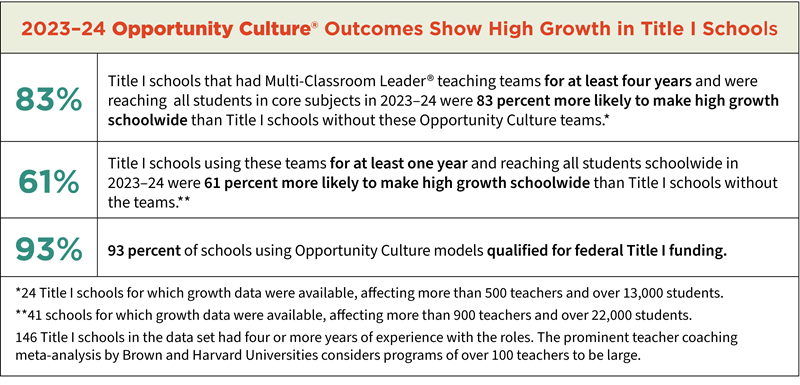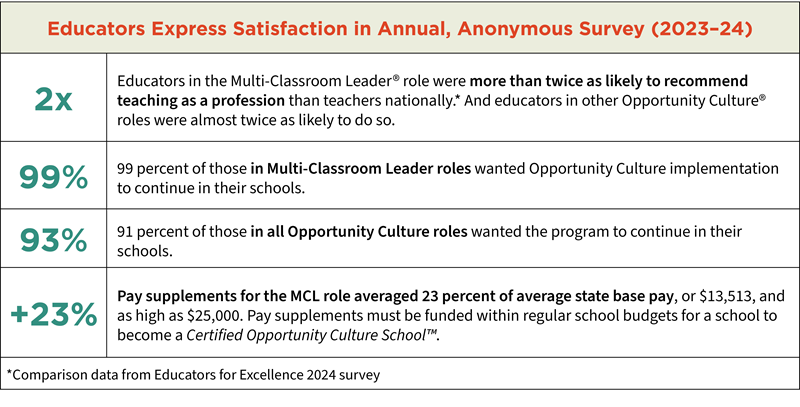In a year of bleak NAEP outcomes, the latest data on schools using Opportunity Culture® teaching teams provides hope for scaling up student learning results nationwide.

Both experience with Multi-Classroom Leader® teams and the percentage of students reached by them affected schoolwide outcomes.
Title I schools that had several years of experience with these teams, which can include new educator roles, and reached students schoolwide showed the best growth results—boosting their odds of high-growth learning schoolwide by 83 percent over schools without the roles.
Schools that reached the most students with excellent teaching through Multi-Classroom Leader teams and sustained their commitment to these roles for 4 years or more were the most likely to achieve high growth schoolwide.
Reaching students mattered more than just gaining years of experience with the roles. Including all students increased the odds of high-growth learning schoolwide by 61 percent, while just gaining experience for four or more years boosted the odds of high growth by 26 percent.
Multi-Classroom Leader roles are filled by excellent teachers with a record of high-growth results, and their teams may include teachers who extend their reach to more students and advanced paraprofessionals who focus on small-group tutoring during the school day. These roles all receive higher pay that is sustainable through reallocations of regular budgets. Recommended pay levels are higher in Title I schools to attract and keep staff in these schools, which serve more students from low-income families than non-Title I schools. Pay supplements for the Multi-Classroom Leader role average 23% of state base pay; the supplements are making it possible for some teachers to reach six-figure salaries.
In 2024–25, 630 U.S. schools are implementing these roles, with hundreds more scheduled to do so; Opportunity Culture educators are serving over 200,000 students across a dozen states. On average, participating schools are reaching about 56 percent of their students with Opportunity Culture teaching teams.
“Schools, systems, and states have far more potential for student learning results—if they reach more students,” said Bryan C. Hassel, co-president of Public Impact® and co-founder of the Opportunity Culture initiative.
A McKinsey analysis indicates that learning results like these boost the economy substantially. This adds jobs and tax revenues to fund national, state, and local priorities. McKinsey included Opportunity Culture models in its Covid learning recovery recommendations.
Ector County ISD in Texas was one of nine school districts highlighted in the recent Stanford-Harvard-Dartmouth Education Recovery Scorecard for its outlier learning gains, and was named K-12 Dive’s 2024 District of the Year. The district uses Opportunity Culture models in about half of its schools. A Texas Tech study in 2021 also found strong student learning growth in that district’s Opportunity Culture implementation, examining teacher-level data. A prior study by the CALDER Center also found learning gains in other districts. On average, these two prior studies found that the models added an extra half year of learning annually in reading and math.
Educators also expressed very strong satisfaction with Opportunity Culture implementation in 2023–24.

Consulting services from Public Impact scored high with clients in our most recent anonymous survey, as well, resulting in a net promoter score of 83. Fifty and over is considered “excellent” for customer net promoter scores, with over 80 being “world class.”
This standout net promoter score followed the introduction of new quality standards in 2023–24, which require schools new to using Opportunity Culture models to become certified—based on data-backed elements—in order to use the initiative’s name and role titles. Hundreds of schools became provisionally certified based on 2023–24 design and implementation, announced in fall 2024.
In the past three years, Public Impact and supportive funders invested in substantially decreasing the cost of the transition to new staffing models through its new design portal, which also captures data about what staffing and pay designs work in different contexts. In 2025–26, Public Impact and funders will be investing in data-gathering to understand how the use of high-quality instructional materials and methods can further boost student learning outcomes, in addition to innovative roles and increased small-group tutoring made possible through Multi-Classroom Leader teams.
Interested in bringing these results to your district or state?
States and school systems now have the option of Self-Driven Design™ with access to the Opportunity Culture portal, and can enhance that as needed with a low-cost coaching package or live, virtual design workshops to collaborate with Public Impact experts on the most challenging aspects of design for a relatively low cost. Many districts also still choose more intensive support, but they join a cohort with other districts to reduce the overall cost of making the shift to Opportunity Culture models.
